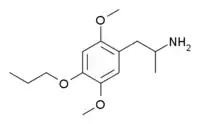MPM (psychedelic)
MPM (2,5-dimethoxy-4-propoxyamphetamine) is a lesser-known psychedelic drug and a substituted amphetamine.
 | |
| Names | |
|---|---|
| Preferred IUPAC name
1-(2,5-Dimethoxy-4-propoxyphenyl)propan-2-amine | |
| Other names
2,5-Dimethoxy-4-propoxyamphetamine; 2,5-Dimethoxy-α-methyl-4-propoxybenzeneethanamine | |
| Identifiers | |
CAS Number |
|
3D model (JSmol) |
|
| ChemSpider | |
PubChem CID |
|
| UNII | |
InChI
| |
SMILES
| |
| Properties | |
Chemical formula |
C14H23NO3 |
| Molar mass | 253.342 g·mol−1 |
Except where otherwise noted, data are given for materials in their standard state (at 25 °C [77 °F], 100 kPa).
Infobox references | |
MPM was first synthesized by Alexander Shulgin. In his book PiHKAL, dosage is given as "30 mg or more" and duration "probably short".[1] MPM is of low potency and produced only slight effects at the highest dose reported in PiHKAL of 30 mg, although its effects at higher doses than this have not been reported.
Very little data exists about the pharmacological properties, metabolism, and toxicity of MPM.
This article is issued from Wikipedia. The text is licensed under Creative Commons - Attribution - Sharealike. Additional terms may apply for the media files.